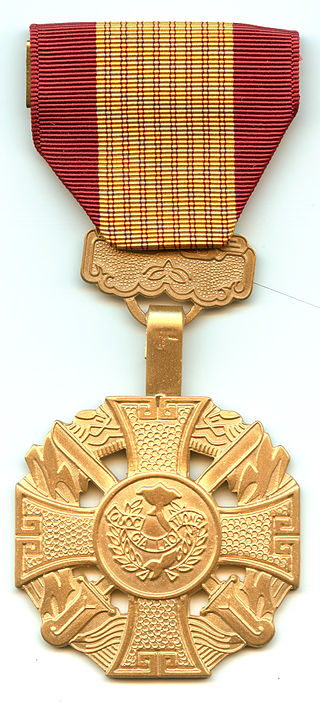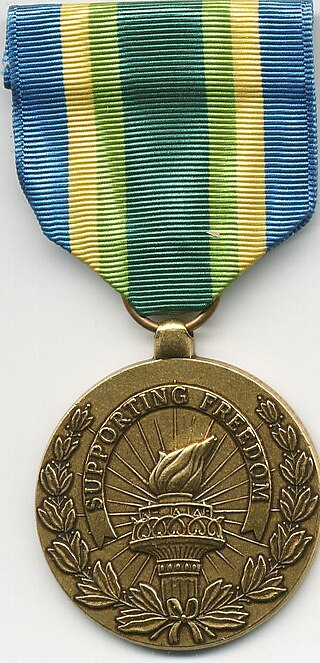
The Bronze Star Medal (BSM) is a United States Armed Forces decoration awarded to members of the United States Armed Forces for either heroic achievement, heroic service, meritorious achievement, or meritorious service in a combat zone.

The Legion of Merit (LOM) is a military award of the United States Armed Forces that is given for exceptionally meritorious conduct in the performance of outstanding services and achievements. The decoration is issued to members of the eight uniformed services of the United States as well as to military and political figures of foreign governments.
The Commendation Medal is a mid-level United States military decoration presented for sustained acts of heroism or meritorious service. Each branch of the United States Armed Forces issues its own version of the Commendation Medal, with a fifth version existing for acts of joint military service performed under the Department of Defense.

The Republic of Vietnam Gallantry Cross also known as the Vietnamese Gallantry Cross or Vietnam Cross of Gallantry is a military decoration of the former Government of South Vietnam. The medal was created on August 15, 1950, and was awarded to military personnel, civilians, and Armed Forces units and organizations in recognition of deeds of valor or heroic conduct while in combat with the enemy.

The Defense Meritorious Service Medal (DMSM) is an award bestowed upon members of the United States military by the United States Department of Defense. In the order of precedence of the United States Armed Forces, it is worn between the Purple Heart and the Meritorious Service Medal. The medal is awarded in the name of the Secretary of Defense to members of the Armed Forces who, while serving in a joint activity, distinguish themselves by non-combat outstanding achievement or meritorious service, but not of a degree to warrant award of the Defense Superior Service Medal.
The National Defense Service Medal (NDSM) is a service award of the United States Armed Forces established by President Dwight D. Eisenhower in 1953. It was awarded to every member of the U.S. Armed Forces who served during any one of four specified periods of armed conflict or national emergency from June 27, 1950 through December 31, 2022. Combat or "in theater" service is not a requirement for the award.
The Antarctica Service Medal (ASM) was established by the United States Congress on July 7, 1960, under Public Law 600 of the 86th Congress. The medal was intended as a military award to replace several commemorative awards which had been issued for previous Antarctica expeditions from 1928 to 1941. With the creation of the Antarctica Service Medal, the following commemorative medals were declared obsolete;
A Sea Service Ribbon is an award of the United States Navy, U.S. Marine Corps, U.S. Coast Guard, the U.S. Army, and the NOAA Commissioned Officer Corps which recognizes those service members who have performed military duty while stationed on a United States Navy, Coast Guard, Army, or NOAA vessel at sea and/or members of the Navy, Marine Corps or Coast Guard who have been forward-deployed with their home unit.
The Vietnam Service Medal is a military award of the United States Armed Forces established on 8 July 1965 by order of President Lyndon B. Johnson. The medal is awarded to recognize service during the Vietnam War by all members of the U.S. Armed Forces provided they meet the award requirements.
The Armed Forces Expeditionary Medal (AFEM) is a military award of the United States Armed Forces, which was first created in 1961 by Executive Order of President John Kennedy. The medal is awarded to members of the U.S. Armed Forces who, after July 1, 1958, participated in U.S. military operations, U.S. operations in direct support of the United Nations, or U.S. operations of assistance for friendly foreign nations.
The American Defense Service Medal was a military award of the United States Armed Forces, established by Executive Order 8808, by President Franklin D. Roosevelt, on June 28, 1941. The medal was intended to recognize those military service members who had served on active duty between September 8, 1939, and December 7, 1941.

The Iraq Campaign Medal (ICM) is a military award of the United States Armed Forces which was created by Executive Order 13363 of U.S. President George W. Bush on 29 November 2004, and became available for general distribution in June 2005. The medal was designed by the U.S. Army Institute of Heraldry and was awarded during the Iraq War, from 19 March 2003 to 31 December 2011.

The Global War on Terrorism Service Medal (GWOT-SM) is a military award of the United States Armed Forces which was created through Executive Order 13289 on 12 March 2003, by President George W. Bush. The medal recognizes those military service members who have supported operations to counter terrorism in the War on Terror from 11 September 2001, to a date yet to be determined.
The European–African–Middle Eastern Campaign Medal is a military award of the United States Armed Forces which was first created on November 6, 1942, by Executive Order 9265 issued by President Franklin D. Roosevelt. The medal was intended to recognize those military service members who had performed military duty in the European Theater during the years of the Second World War.
The American Campaign Medal is a military award of the United States Armed Forces which was first created on November 6, 1942, by Executive Order 9265 issued by President Franklin D. Roosevelt. The medal was intended to recognize those military members who had performed military service in the American Theater of Operations during World War II. A similar medal, known as the American Defense Service Medal was awarded for active duty service before the United States' entry into World War II.
The Medal for Humane Action is a military award of the United States Armed Forces which was created by an act of the United States Congress on July 20, 1949. The medal recognizes those military service members who performed extended duty in support of the Berlin Airlift. The medal is based on the design of the Berlin Airlift Device.
The Army of Occupation Medal is a military award of the United States military which was established by the United States War Department on 5 April 1946. The medal was created in the aftermath of the Second World War to recognize those who had performed occupation service in either Germany, Italy, Austria, Japan or Korea. The original Army of Occupation Medal was intended only for members of the United States Army, but was expanded in 1948 to encompass the United States Air Force shortly after that service's creation. The Navy and Marine equivalent of the Army of Occupation Medal is the Navy Occupation Service Medal, which features the same ribbon with its own medallion and clasps.
The Armed Forces Service Medal (AFSM) is a military award of the United States military that was created on January 11, 1996, by President Bill Clinton under Executive Order 12985. The AFSM is a deployed service medal that is presented to those service members who engage in "significant activity" for which no other U.S. campaign or service medal is authorized.
The Spanish War Service Medal was a United States military medal of the U.S. Army which was established by an act of the U.S. Congress on 9 July 1918. The medal recognizes those members of the Army and of the U.S. Volunteers who performed active duty during the Spanish–American War, but did not qualify for the Spanish Campaign Medal.

The Armed Forces Civilian Service Medal (AFCSM) is established to recognize the contributions and accomplishments of the U.S. Department of Defense civilian workforce who directly support the military forces, when those members are engaged in military operations of a prolonged peacekeeping or humanitarian nature. The AFCSM symbolizes the importance the Department of Defense attaches to civilian service and recognizes the value of civilian service in helping to accomplish the U.S. Government's objectives. This award honors those employees who support designated operations under the same or similar conditions as U.S. military members, thereby strengthening the partnership between the civilian services and uniformed services.






